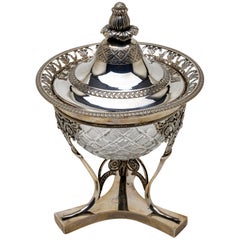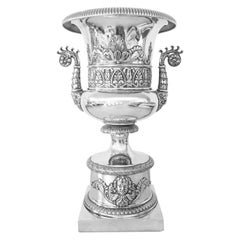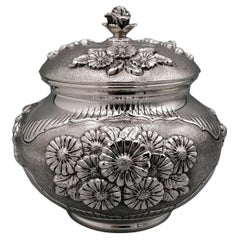Cristoforo Corbella Sterling Silver
to
1
1
1
1
1
1
1
1
1
1
1
1
1
1
415
396
335
316
Creator: Cristoforo Corbella
19th Century Italian Neoclassical Silver and Crystal Compote with Cover
By Cristoforo Corbella
Located in Milano, MI
From Milan a 19th century Italian silver and crystal compote bowl in good condition from a private collection. This antique Neoclassical covered compote bowl has a very fine hand-chased vegetal decoration and engraving, a lovely cast engraved silver 800/000 finial and shows silver-maker’s mark for Cristoforo Corbella active in the first half of 19th century in Milan, contrada degli Orefici 3194.
This antique silver compote of supreme craftsmanship stands on a three-lobed pedestal base with B L monogram engraved in the central part, features tripod legs decorated with neoclassical motifs, scrolls, flowers, rosettes supporting a circular upper ring adorned with elegant acanthus leafed piercing.
Engraved crystal cup and a cover finely engraved with geometrical and vegetal pattern, surmounted by a cast gem finial.
The following marks can be seen on the bottom of the foot and the upper edge of the compote, (the original descriptions are reported, as they appear on the documents of the State Archive of Milan):
1) “Forma eptagona. Globo col Zodiaco ed i setti (sic) Trioni” Heptagon form. Globe with the Zodiac and the seven Trioni (seven stars of the Ursa Major) Mark of the Guarantee Office in use in the Napoleonic Kingdom of Italy from 1812 for works with a title of 800 thousandths.
2) "Aratro" Plow Mark of the Guarantee Office in use in the Napoleonic Kingdom of Italy from 1812.
3) "insegna della Luna Piena...
Category
Mid-19th Century Italian Neoclassical Antique Cristoforo Corbella Sterling Silver
Materials
Crystal, Silver
Related Items
Early 19th Century Italian Neoclassical Silver Urn Vase Milan by Emanuele Caber
Located in Worpswede / Bremen, DE
A very decorative neoclassical silver urn stamped by the Italian silversmith Emanuele Caber, dating from around 1825. It has the Milan warranty stamp, and stamp of the silver finenes...
Category
Early 19th Century Italian Neoclassical Antique Cristoforo Corbella Sterling Silver
Materials
Silver
$2,861
H 10.24 in W 4.14 in D 4.14 in
19th Century Italian Sterling Silver Decorative Box
By Arval Argenti Valenza
Located in VALENZA, IT
Completely handmade sterling silver candy box.
The box is round and pot-bellied.
Embossments and chisels of flowers were made all over the body.
The box is divided into three sect...
Category
2010s Cristoforo Corbella Sterling Silver
Materials
Sterling Silver
Pair Italian Neoclassical Silver Salts With Hermes
Located in New York, NY
Pair Italian neoclassical silver salts with hermes. Pair of antique neoclassical sterling silver salt stands of Empire tripod form with pierced anthemion band supported by Hermès on ...
Category
Early 19th Century Italian Neoclassical Antique Cristoforo Corbella Sterling Silver
Materials
Crystal, Sterling Silver
Silver Tray with Embedded Silver Coins 19th Century
Located in Madrid, ES
Silver tray with embedded silver coins. European work from the late 19th century.
Measures: 30 x 25 x 8 cm.
Category
19th Century European Baroque Antique Cristoforo Corbella Sterling Silver
Materials
Silver
Italian Silver Mermaid Chamberstick, 19th Century
Located in Charlottesville, VA
Italian silver (with marks) chamberstick, 19th Century, having a wonderful mermaid thumb-hold. Find guilloche and rib, and floral -detailing on the stick and cap. 3” h. x 4 ¾” diam...
Category
19th Century Italian Antique Cristoforo Corbella Sterling Silver
Materials
Silver
19th Century Italian Gilt Sterling Silver And Enamel Picture Frame
Located in Norwood, NJ
Antique (gilt) vermeil over sterling silver ornate picture frame with red and blue vitreous enamel, Italy, circa 1890. Has hallmark on front. Oval...
Category
Early 1900s Italian Rococo Antique Cristoforo Corbella Sterling Silver
Materials
Gold Plate, Enamel, Sterling Silver
20th Century Italian Sterling Silver Pair Candelabras Neoclassical Style
By Mario Poli
Located in VALENZA, IT
Pair of 5-light candelabra in 925 sterling silver in neoclassical style.
Candelabra formed by an iron eye stem and a Hellenic part in Ionic style in 925 silver.
The iron eye is a sto...
Category
1990s Italian Neoclassical Cristoforo Corbella Sterling Silver
Materials
Sterling Silver
$17,288
H 15.36 in Dm 11.03 in
Sterling Silver Salver with Reticulated Border, 19th Century
Located in Savannah, GA
Sterling Silver Salver with Reticulated Border, 19th Century
Category
19th Century Antique Cristoforo Corbella Sterling Silver
Materials
Sterling Silver
19th Century Italian Sterling Silver Madonna, circa 1830
Located in Milano, IT
Embossed and engraved silver plaque
La Madonna del lago (The Madonna of the Lake)
Probably Milan, post 1824
Brass frame
It measures 16.14 in x 13.85 in (41 x 35.2 cm) and it weighs 10.357 pounds (4.698 g): silver 1.31 pounds (598 g) + brass 9.03 pounds (4.100 g)
State of conservation: some abrasions on the bottom. The frame is old, but not original.
The plaque is made up of a sheet of embossed and engraved silver, and held in a solid brass frame. It depicts the “Madonna del lago” – “Madonna of the Lake” - (the Madonna with Child and San Giovannino) by Marco d'Oggiono (Oggiono, 1474 circa - Milan, 1524 circa), while changing only the background landscape. Almost certainly the subject reproduced in the plaque was taken from a famous engraving by Giuseppe Longhi (Monza, 1766 - Milan, 1831), one of the greatest engravers of his era.
The silver is unmarked, probably because originally the Madonna was due to be exposed in a church: sometimes precious metals destined for worship and liturgical use would be exempted from payment and were, therefore, not marked.
It is very likely that the plaque was made in Milan because in this city in 1824 the engraving by Giuseppe Longhi was made and printed. In addition, in Milan, the alleged lost painting by Leonardo da Vinci in his Milanese period (1482-1500) would be produced; this is the painting from which Marco d'Oggiono took his version.
The painting
Marco d?Oggiono was one of Leonardo da Vinci's most brilliant students and collaborators (D. Sedini, Marco d’Oggiono, tradizione e rinnovamento in Lombardia tra Quattrocento e Cinquecento, Roma 1989, pp. 151-153, n. 56; p. 225, n. 124, with previous bibliography). His style reflects in every way that of the Tuscan Maestro, so much so that he was the one who executed some copies of da Vinci's paintings. The execution of the “Madonna del Lago” probably draws inspiration from a lost painting by the Maestro, created while he was living in Milan (1482-1500). There are many similarities with other works by Leonardo such as the “Vergine delle rocce” or the “Vergine con il Bambino e San Giovannino, Sant’Anna e l’Agnello”.
The painting, from which the drawing and then the famous engraving were taken, is found today at the M&G Museum of Bob Jones University in Greenville, South Carolina, where it came to rest after the sale of the Harrington Collection in London in 1917.
The work appears in the inventories of the collection of Napoleon and Joséphine Bonaparte at the castle of Malmaison, before 1809.
The Malmaison building was born and developed in the 17th and 18th centuries. In the 18th century it belonged to Jacques-Jean Le Coulteux du Molay, a wealthy banker. Later, during the Directory, Joséphine Bonaparte de Beauharnais bought it on April 21st, 1799, but settled at the castle definitively only after her husband separated from her in 1809. She remained there until 1814, the year of her death. When Joséphine died, the estate passed to her son Eugène de Beauharnais, who moved to Munich with his whole family in 1815, bringing with him the collection of paintings he inherited from his mother. Eugène died in 1824 and his wife Augusta of Bavaria (von Bayern), unable to keep it, in 1828 sold the Malmaison to the Swedish banker Jonas-Philip Hagerman.
It is likely that in this period Augusta also sold part of the paintings inherited from her husband, including the “Madonna del Lago”. This painting then came into the possession of Leicester Stanhope, fifth Earl of Harrington (1784 - 1862) and then was passed down to his descendants.
In 1917, at the death of Charles, eighth Earl of Harrington, his brother Dudley inherited the title and properties and he put up a part of his collections for sale. Among these, precisely, the painting by Marco d'Oggiono was to be found.
On the occasion of that auction the painting was presented as a work by Cesare da Sesto, by virtue of a handwritten note by the Countess of Harrington on the back of the table. However, already in 1857, the German critic Gustav Waagen had identified Marco d'Oggiono as the author of the painting, then exhibited in the dining room of Harrington House in London (Treasures of Art in Great Britain, in 4 volumes, London, 1854 and 1857).
The engraving
Giuseppe Longhi was one of the most renowned engravers in Italy between the end of the 18th century and the first quarter of the 19th century.
In 1824 Giuseppe Longhi, based on a design by Paolo Caronni, made a famous engraving of the painting of Marco d?Oggiono. The activity of Longhi was then at the peak of his notoriety, enough to earn him very substantial commissions; it is not risky to suppose that some of his successful engravings were also reproduced using other means: in our case in silver. (A. Crespi, a cura di, Giuseppe Longhi 1766–1831 e Raffaello Morghen...
Category
1820s Italian Neoclassical Antique Cristoforo Corbella Sterling Silver
Materials
Sterling Silver, Brass
Sterling and Crystal Compote
By Steuben Hawkes
Located in Brooklyn, NY
Based in Corning, NY, T.G. Hawkes & Co. (circa 1880-1959) was established by Thomas Gibbons Hawkes (1846-1913). Born in Ireland, Hawkes immigrated to Brooklyn in 1862, then moved to ...
Category
Early 1900s American Antique Cristoforo Corbella Sterling Silver
Materials
Crystal, Sterling Silver
19th Century Continental Silver and Cut Crystal Pitcher
Located in Hamilton, Ontario
19th century continental silver and cut crystal pitcher.
Category
19th Century European Antique Cristoforo Corbella Sterling Silver
Early 19th Century Dutch Silver and Diamond Cut Crystal Cruet Set, 1816
Located in Delft, NL
A early 19th century Dutch silver and diamond cut crystal cruet set, 1816
A silver standard with three diamond cut crystal bottles and a sprinkle...
Category
Early 19th Century Dutch Antique Cristoforo Corbella Sterling Silver
Materials
Crystal, Silver
$2,831 / set
H 9.65 in W 7.09 in D 4.73 in
Cristoforo Corbella sterling silver for sale on 1stDibs.
Cristoforo Corbella sterling silver are available for sale on 1stDibs. These distinctive items are frequently made of stone and are designed with extraordinary care. There are many options to choose from in our collection of Cristoforo Corbella sterling silver, although silver editions of this piece are particularly popular. Many of the original sterling silver by Cristoforo Corbella were created in the neoclassical style in italy during the 19th century. Prices for Cristoforo Corbella sterling silver can differ depending upon size, time period and other attributes — on 1stDibs, these items begin at $2,765 and can go as high as $2,765, while a piece like these, on average, fetch $2,765.


